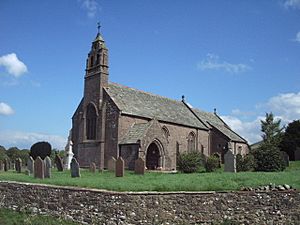St Michael, Lamplugh facts for kids
Quick facts for kids St Michael, Lamplugh |
|
|---|---|

St Michael, Lamplugh
|
|
| Lua error in Module:Location_map at line 416: Malformed coordinates value. | |
| , | |
| OS grid reference | NY 0885320799 |
| Location | Lamplugh, Cumbria |
| Country | England |
| Denomination | Anglican |
| History | |
| Status | Parish church |
| Dedication | St Michael |
| Administration | |
| Parish | Lamplugh |
| Deanery | Calder |
| Archdeaconry | West Cumberland |
| Diocese | Carlisle |
| Province | York |
St Michael's Church is located in Lamplugh, a village in Cumbria, England. It is an active Anglican church, meaning it belongs to the Church of England. The church is an important local building. It is listed as a Grade II building, which means it is a special historic building that needs to be protected.
Contents
History of St Michael's
St Michael's Church was built in 1870 by a famous architect named William Butterfield. However, it kept some older parts from earlier churches on the same spot. People believe a chapel or church has been here since the year 1150. The church was rebuilt or repaired two times before, in 1658 and 1771.
The small room called the vestry was once part of the Lamplugh family's private chapel. This was a place where family members were buried.
Bells and Old Features
The church has a bell tower with two bells. One bell is very old, dating back to the 1400s. The other bell was made in 1870 by a company called John Taylor & Co in Loughborough.
Some parts of the church are from the medieval period (Middle Ages). For example, there is a doorway in the north wall of the chancel (the area around the altar) that is now blocked up. You can still see where it was from the outside.
The church also has three gargoyles on its outer east wall. Gargoyles are carved stone figures, often shaped like monsters, that were used to drain water from the roof. These gargoyles were moved from an older building. The church's style, called "Perpendicular Gothic," was popular in earlier times. It is thought that Butterfield used this style to match the older parts of the church. The church walls are made of sandstone, and the roof is slate.
Stained Glass Windows
St Michael's has beautiful stained glass windows. Two of these windows were made by Charles Eamer Kempe in 1891 and 1901. Two more came from his workshop, Kempe & Co. Ltd., in 1910 and 1911. Another window, from 1903, was made by Heaton, Butler and Bayne of London. The other three windows are believed to be by Clayton and Bell, another London company.
Remembering Local Heroes
In November 2018, a special "Honours Board" was put up in the church. This board lists all the people from the Lamplugh area who served in World War I. The Lamplugh and District Heritage Society did the research to create this important memorial.
Church Design and Inside
St Michael's Church is built from local sandstone. The walls are made of rough, squared stones. The roof is made of slate tiles that get smaller towards the top. There is a bell tower at the west end and crosses at the east end.
The church has a main hall called the nave and a chancel (the area near the altar) with a vestry on the south side. The main entrance has a wooden door with a pointed top, leading into a small porch.
Inside the Church
The roof inside the nave has a special design called a "scissors truss." This makes the roof look like a series of "X" shapes. There are also wide, pointed arches leading to the chancel and vestry.
The church has an octagonal (eight-sided) wooden pulpit in the northeast corner of the nave. A pulpit is where the priest gives sermons. At the west end, there is a red octagonal stone font, which is used for baptisms. Both the pulpit and font are from the 1800s.
You can also see some old stone slabs and marble memorials inside the church. The altar has a symbol called "IHS," which is a short form of Jesus's name. The ceiling of the chancel is painted blue. The church also has an organ, a separate toilet, and a washroom.
War Memorials
St Michael's Church is a place of remembrance for those who served in wars. There are two war graves here:
- One from World War I for J.E. Sewell, who was 19 when he died in 1918.
- One from World War II for J. Benn, who was 22 when he died in 1943.
Just outside the church, there is a war memorial that was officially opened in June 1921. It lists 30 names of people from the area who died in World War I and four names from World War II.

